Name: Plantain, Common
Botanical Name: Plantago major
Form: wildflower
Parts Used: greens, seeds
Citation: Guenther, K. (2017, January 12) Common plantain as wildlife food [Web log post.] Retrieved:readers supply the date, from http://wildfoods4wildlife.com
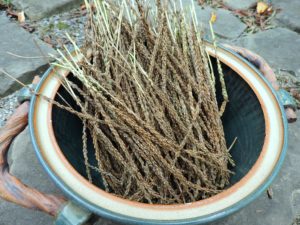
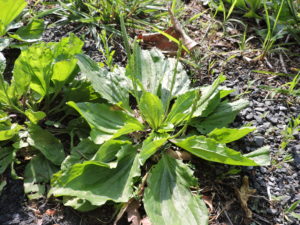
Getting Started
Plantain is an easy-to-find backyard weed. It is easy to identify and a good beginner forager plant. On our Great Greens list, plantain ranks 68th. And on our Super Seeds list, it ranks 111th , neither which is super high and popular, but I include this monograph because it is such an easy-to-identify and readily accessible plant for beginner foragers. Plus, it is decent salad green for cottontails, and rehabbers often have a lot of cottontail mouths to feed!
The plantains you will most frequently find are the non-natives—common and narrow-leaf plantain. Since plantain is also a common roadside weed, be sure to harvest greens and seeds from plants that are at least 50 feet away from roadsides, so food is not contaminated by exhaust toxins and toxic runoff.
Plantaginaceae (Plantain family)
Plantagineae (Plantain tribe)
Plantago (Plantain genus)
Avoiding the two threatened plantains, goose tongue and heartleaf plantain, you can harvest and offer the seeds or greens of any of the Plantago species in Virginia for rehabilitation patients.
| Common name | Virginia Plantago Species | Origin | Rare Plant Status |
| large-bract plantain | P. aristata | native | not rare |
| heartleaf plantain | P. cordata | native | Globally secure but of concern, may already be extirpated from the Virginia |
| slender plantain | P. heterophylla | native | not rare |
| narrow-leaf plantain | P. lanceolata | non-native | not rare |
| common plantain | P. major | non-native | not rare |
| seaside plantain | P. maritima | native | Globally secure, but critically imperiled in Virginia |
| wooly plantain | P. patagonica | native | yes, in some states (not Virginia) |
| dwarf plantain | P.prusilla | native | yes, in some states (not Virginia) |
| blackseed plantain | P. rugelii | native | not rare |
| Virginia plantain | P. virginica | native | yes, in some states (not Virginia) |
| Wright’s plantain | P. wrightiana | native | not rare |

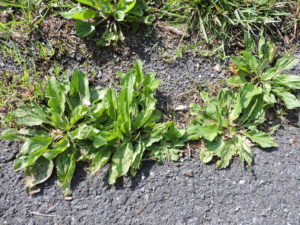
Key Features to Look For
In addition to using the identification guide of your choice, here are a couple of features you should see on this plant:
- seemingly parallel veins in the leaf that can be mistaken as a monocot-style leaf
- leafless spikes are the flower heads containing minute, indistinguishable flowers
- rosette of leaves at ground level (basal)- all leaves coming out of the same spot, no stalk
- plants are ankle height or shorter
Risks
None indicated.
About this Species
In Virginia, common plantain (P. major) produces the most seeds for your effort. Greens toughen and get more fibrous as the season wears on, and rabbits probably prefer the younger, smaller leaves of early summer. But late summer plants can be collected as well.
Flower Description: Flowers bloom along a spike and are numerous green/pink/white, inconspicuous small flowers. Flower stalks are tall and slender.
Leaf Description: The basal rosette of leaves at a glance appear to have parallel veins, but smaller net veins between the parallel veins are visible if you look very closely. The main ribs on the back of the leaf are show very prominently. The leaves do not have a stalk, they come out of the same place (rosette). The flower stalk of the plant is leafless.
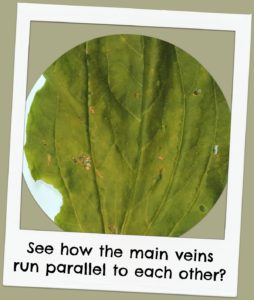
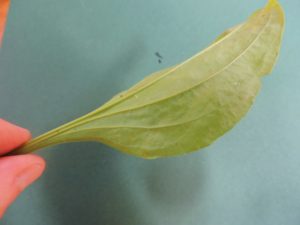
Seed Size: Cleaned, husk-less seed is very small, oblong, dark and irregularly shaped 3/16 inch (2 mm). It is ¼ inch (6 mm) long if seed is still in the light, tan husk.
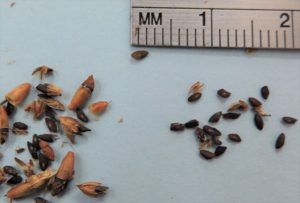
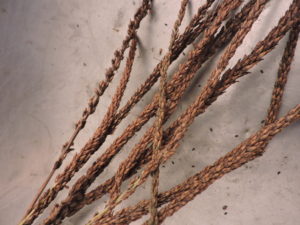
Harvesting
| Jan | Feb | Mar | Apr | May | Jun | Jul | Aug | Sep | Oct | Nov | Dec | ||||||||||||||
|---|---|---|---|---|---|---|---|---|---|---|---|---|---|---|---|---|---|---|---|---|---|---|---|---|---|
| winter | winter | late winter | early spring | spring | late spring | early summer | summer | late summer | early fall | fall | late fall | ||||||||||||||
| seed | x | x | x | ||||||||||||||||||||||
| greens | x | x | x | x | x | x | x | x | x | x | |||||||||||||||
Does this lend itself to being a good enrichment item? Yes! Common plantain has a substantial enough stem to stand upright in a bouquet of plantain spikes once the seeds are ripe. Bundle the spikes together and insert them into a heavy, rugged dry vase to allow the cardinals and others to pull the seeds at will.
In addition, you can grow plantain from seed in pots and add the potted live plants into enclosures.
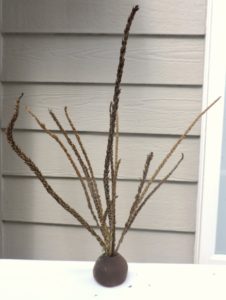
Nutrition: It is high in calcium and vitamins A, C, and K. (Elpel, 2013).
Harvesting Plantain Seed
Harvest when the tall seed stalks turn brown, late summer to fall, but before the seeds on the stalk look deteriorated. Cut the ripe spikes and allow to dry fully a week to a month. Then pull the seeds from the stalk through your hand and deposit husks and seed in a bucket. When fully dry, the mature seeds should fall out of the husks, leaving the tan color hollow husk and the dark orange-brown seed (which can look a lot like mouse feces). You might be able to carefully winnow the seed from the chaff, but you are likely to lose a lot of seed, because the plantain seeds are so small and lightweight. I’d offer the seed and chaff and let the birds do the sorting.
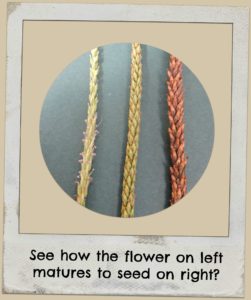
How to Store Prepared Seed: Once cleaned and fully dried, choose a low humidity day—not a rainy day—to jar up your seed.
Glass or metal works best, because all plastics are somewhat porous to humidity. Canning jars and lids work well. Place seed in a tightly sealed, glass container and store in a dark, cool area for up to 1 year. Refrigeration and freezing work well. Label the airtight container with the seed name, date of harvest and which animals it should be used for.
If you intend to keep the seed longer than one year, jar up the seeds in two stages. First, jar the seeds up using a desiccant for up to 1 week. Then check the seed for dryness, and if dry enough, remove the desiccant and immediately repack the seed into an airtight container. Read more about drying seeds and using desiccants under the tab “Harvest, Cleaning and Storage.”
Keep stored seed in an airtight glass or metal container in a cool, dark place. Refrigeration and freezing works well, but allow container to warm to room temperature before opening. Discard any seed that ever appears moldy.
Harvesting Plantain Greens: Green leaves can be harvested at anytime spring to fall, but are tastier and less fibrous when young and small in late spring. Small plants can be pulled up whole after a rain. By leaving the roots attached, the greens will stay fresher longer in the refrigerator, up to 1 week.
How to Store Prepared Greens: If you choose to, use a commercial vegetable cleaner or a ¼ cup (60 ml) of vinegar added to wash water as a cleaner. Submerge the plant material and swish it around to remove all dirt from leaves and roots. Rinse in clean water. Always wash greens; you never know what might be on them…like animal feces or urine. Place in a colander or salad spinner to drain, then layout a towel and spread the greens on the towel and roll up the towel. Unroll and transfer the damp greens to storage.
For storage, there are a couple of different possible container methods. If the greens will be used quickly within days, place the spun-and-towel-rolled damp greens to a 1 gallon zip-lock baggie with 12-15 holes cut in it to provide air and keep the greens from molding (or reuse commercial grape bags with holes). Label the bag with the plant name and which animals it should be used for. Keep container in the vegetable drawer of the refrigerator.
For storage longer than one week, use a rigid, lidded, airtight container. After washing and salad spinning the greens, place a paper towel in the bottom, then loosely fill with greens, but do not pack them in. Then lay a paper towel on top and put on lid. Keep container in the vegetable drawer of the refrigerator. Do not use if greens become moldy, slimy or dried out.
Many greens are very sensitive to exposure to ethylene gas, though greens themselves are low emitters of the gas. You may get longer quality by adding with a product that reduces free ethylene gas in the refrigerator. Greens are good until they become dry and crispy, fade in color, or become slimy or moldy.
Read more about storing leafy greens.
Other Species
Narrowleaf plantain is another common plant neighbor in most people’s yards. Its greens and seeds can be used as well.
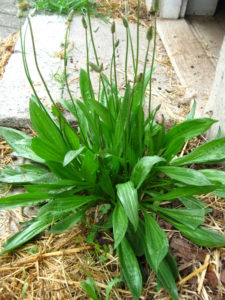
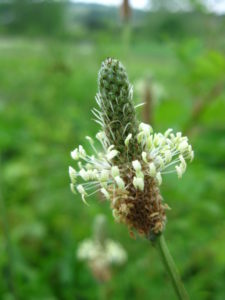
Rare Species in Virginia
Do you live in one of these Virginia counties? If so, be aware that there are some species near you that may be threatened or endangered. Do more research to make sure you are identifying your target species correctly and not harvesting a threatened species!
| County in Virginia | Species | Alert |
| Accomack | seaside plantain | Globally secure, but critically imperiled in Virginia |
| Fairfax | heartleaf plantain | Globally secure but of concern, may already be extirpated from the Virginia |
| Smyth | heartleaf plantain | Globally secure but of concern, may already be extirpated from the Virginia |
(Townsend, J. F., 2015)
In addition to common plantain, narrow-leaf plantain (also known as English plantain) is another very common backyard plant from which seeds and greens can be collected in a similar fashion to above.
For foragers in counties where heartleaf plantain occurs, the best way to identify common plantain is to look at the leaf and make sure the leaf is almond shaped (ovate) is not heart-shaped (cordate).
Seaside plantain is only a concern for Virginia foragers in Accomack Co. You will see some resemblance to narrow-leaf plantain, but you’ll see differences, too. Like narrow-leaf plantain, the leaves are long and narrow, and the whole plant grows in a larger clump with many flower spikes. But the inflorescence flower spike is more elongated and thicker along the stem. Seaside plantain is believed to only be on Assateague and Wallops Islands (Weakley, Ludwig and Townsend, 2015).
Feed Plantain to:
plantain | (Plantago spp.) | greens |
|---|---|---|
Cottontail, Eastern | Sylvilagus floridanus |
|
Deer, White-tailed | Odocoileus virginianus |
|
Grouse, Ruffed | Bonasa umbellus |
|
plantain | (Plantago spp.) | seeds |
Mouse, Common White-footed | Peromyscus leucopus |
|
Cardinal, Northern | Cardinalis cardinalis |
|
Sparrow, Grasshopper | Ammodramus savannarum |
|
Book References:
Elpel, T.J. (2013) Botany in a Day (APG). Pony, Montana: Hops Press, LLC.
Martin, A.C., Zim, H.S., Nelson, A.L. (1951). American Wildlife and Plants: A Guide to Wildlife Food Habits. New York: Dover Publications.
Scott, M. (2013). Songbird Diet Index. National Wildlife Rehabilitators Association, St. Cloud, MN.
Townsend, J. F. (2015, April) Rare Plants Natural Heritage Technical Report 15-10. (Unpublished Report) Richmond, Virginia: Virginia Department of Conservation and Recreation, Division of Natural Heritage.
Weakly, A.S., Ludwig, J.C., & Townsend, J.F. (2012) Flora of Virginia. Fort Worth, Texas: Botanical Research Institute of Texas Press.
On-line References
USDA, NRCS. 2015. The PLANTS Database (http://plants.usda.gov, 9 November 2015). National Plant Data Team, Greensboro, NC 27401-4901 USA.
Virginia Botanical Associates. (Accessed November 2015). Digital Atlas of the Virginia Flora (http://www.vaplantatlas.org). c/o Virginia Botanical Associates, Blacksburg.
